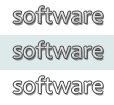Custom Database Design and Programming
DataGnostics' database design lead is Dirk Goldgar, Microsoft Access Most Valuable Professional since 2001: one of about 80 active experts in the field who are recognized worldwide. He has more than 25 years' experience with PC and mainframe systems.
Our experience in custom database and software development for large and small businesses, government, financial institutions, and hospitals, leads us to design databases according to certain principles.
The database must reflect the real problem domain
The first step in custom database development is creating a database structure that accurately models the real world "problem domain": the people, objects, events or transactions in question. Sometimes the underlying structure of the problem domain is obvious; sometimes the client already knows what it is. Other times we need to interview people, watch how they work, look at what appears to be chaos and resolve it into clear-cut and logical entities that interact in very specific ways. With this understanding we can develop a clean, accurate data model, leading to an effective and powerful solution.
Getting results from the database takes experience
After we've developed a database structure that reflects the reality of the problem domain, extracting the desired results is comparatively straightforward. Presenting these results in a way that is intuitive and easy to use takes experience and understanding of the people involved and of the capabilities of the user interface, whether Microsoft Access, Visual Basic, or a web page.
The same basic approach works in many fields
We have used this basic approach for a variety of projects, including:
- personnel management
- athletic club management
- database-driven publication
- inventory control
- asset management
- general ledger & accounting
- billing & chargeback management
- medical information systems








